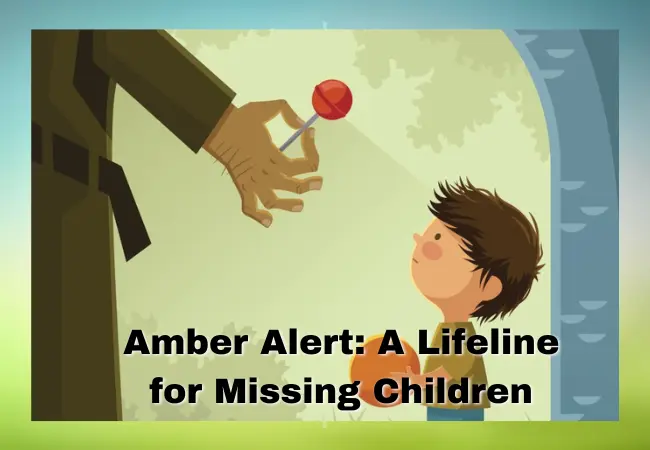In today’s interconnected world, rapid response and coordination during child abductions are crucial. The Amber Alert system has become a vital tool in reuniting missing children with their families by involving the public in the search. Named after Amber Hagerman, a young girl who was abducted and murdered in Texas in 1996, this alert system aims to disseminate urgent information about missing children to the public via various media channels.
In this article, we’ll explore the system’s purpose, functionality, success stories, and the challenges it faces in a complex modern world.
What is an Amber Alert?

An Amber Alert is a child abduction emergency bulletin issued by law enforcement agencies. Its primary objective is to leverage public awareness to assist in locating a missing child in imminent danger. Alerts are broadcast through various mediums, including:
- Television and radio broadcasts
- Highway signs
- SMS text alerts
- Internet and social media platforms
By reaching a broad audience quickly, these alerts increase the chances of locating the child and bringing them to safety.
The Purpose of Amber Alerts
The primary purpose of the Amber Alert system is to inform the public when a child is in danger quickly. Law enforcement agencies rely on the public’s vigilance, encouraging people to be on the lookout for specific vehicles, individuals, or children. The collaboration between law enforcement, media, and the public creates a robust network for tracking potential abductors.

How Amber Alerts Work
The process of issuing follows strict guidelines to ensure its effectiveness. An alert is not issued for every missing child; instead, there are specific criteria that must be met
You may also like to read: The Life and Legacy of a True Acting Legend
Criteria for Issuing an Amber Alert
- Confirmation of Abduction: Law enforcement must confirm that a child has been abducted. This excludes situations like runaways or custodial disputes unless there is credible evidence of danger.
- Age of the Child: The child must be under 18 years old.
- Imminent Danger: There must be a belief that the child is in immediate danger of serious bodily harm or death.
- Sufficient Information: There should be enough descriptive information (such as the abductor’s vehicle description or the child’s clothing) to make a public broadcast useful.
Public Engagement
Once the criteria are met, law enforcement agencies disseminate through the Emergency Alert System (EAS). Public service announcements across media platforms and the participation of the public become crucial in these critical hours.
Social media platforms like Facebook, Twitter, and Instagram have also become instrumental in amplifying. The wider the reach, the greater the likelihood that someone will recognize the child or the abductor.
The Success of Amber Alerts
The effectiveness of the Amber Alert system can be seen through numerous success stories where abducted children were quickly found, thanks to the public’s vigilance. Since its inception, the system has saved over 1,000 children in the United States alone.
Notable Success Stories
The Case of Shaniya Davis (2009)
In 2009, the Amber Alert system played a critical role in locating 5-year-old Shaniya Davis, who had been abducted in North Carolina. Law enforcement used to distribute her description across various platforms, leading to a swift response from the public. Unfortunately, Shaniya was found deceased, but the system helped law enforcement track down the abductor, who was later arrested and convicted.

The Case of Hannah Anderson (2013)
Another successful Amber Alert case occurred in 2013 when 16-year-old Hannah Anderson was abducted by a family acquaintance in California. Her abduction triggered an, which helped raise awareness and mobilized multiple law enforcement agencies. After being held captive for a week, Anderson was found in Idaho, and her abductor was killed in a shootout with law enforcement.
Challenges Facing Amber Alerts
While Amber Alerts have proven to be effective in many cases, the system is not without challenges.
False Alarms
One of the most significant challenges is the potential for false alarms. If an is issued prematurely or without substantial evidence, it can cause public desensitization. Overuse or misapplication of the system may lead to a situation where people ignore reducing their overall effectiveness.
Limited Public Awareness
Another issue is the limited public awareness of how to respond While many people receive these alerts on their phones or hear them on the radio, they may not know what steps to take when they spot someone matching the description. Educating the public on how to appropriately respond to Amber Alerts is crucial for maintaining the system’s success.
Technology Gaps
Although technology plays a crucial role in the distribution of Amber Alerts, gaps in accessibility still exist. For instance, areas with poor internet or mobile coverage may not receive the alerts promptly. Additionally, some older devices may not support modern alert systems, reducing the overall reach.

How to Respond to an Amber Alert
When an Amber Alert is issued, it’s essential for the public to understand how to respond appropriately. Here are some tips:
- Pay Attention to Details: Be sure to note any critical information provided in the alert, such as vehicle descriptions, license plate numbers, and any physical identifiers.
- Stay Vigilant: While going about your daily activities, keep an eye out for any signs of the child or suspect.
- Report Immediately: If you believe you’ve seen something related to the alert, contact law enforcement immediately. Provide as much information as possible without putting yourself in danger.
The Future of Amber Alerts
The Amber Alert system continues to evolve as new technologies emerge and public safety becomes an increasingly high priority. Innovations in geofencing and artificial intelligence (AI) are poised to make Amber Alerts even more effective in the future.
Geofencing Technology
Geofencing allows alerts to be sent to mobile devices within a specific geographic area. This ensures that only people in the relevant region receive the Amber Alert, reducing unnecessary alarms in far-flung areas where the child is unlikely to be found.
AI and Predictive Analytics
By using AI and predictive analytics, law enforcement can better understand abduction patterns and refine their approach. Predictive models can help narrow down potential search areas and improve the chances of a successful recovery.
Conclusion
The Amber Alert system has become an indispensable tool in modern child abduction cases. By fostering collaboration between law enforcement, media, and the public, Amber Alerts increase the likelihood of reuniting missing children with their families. While challenges remain, advancements in technology and public awareness will continue to enhance the system’s efficiency, ultimately saving more lives in the years to come.
Amber Alerts remind us of the importance of community involvement in child safety. The next time you receive an alert, stay vigilant—it could make all the difference in saving a child’s life.
By supporting the Amber Alert system, we strengthen the security of our communities and protect the most vulnerable among us.




